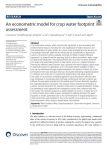Niccolucci V., Kemda M.M., Marchi M., Cai G., Montefrancesco C., Parri S., Di Noi A., Alberti E. (2025). An econometric model for crop water footprint assessment. Discover Sustainability, 01/12/2025, vol. 6, n. 1, p. 756.
https://doi.org/10.1007/s43621-025-01520-2
https://doi.org/10.1007/s43621-025-01520-2
| Titre : | An econometric model for crop water footprint assessment (2025) |
| Auteurs : | V. Niccolucci ; M.M. Kemda ; M. Marchi ; G. Cai ; C. Montefrancesco ; S. Parri ; A. Di Noi ; E. Alberti |
| Type de document : | Article |
| Dans : | Discover Sustainability (vol. 6, n. 1, December 2025) |
| Article en page(s) : | p. 756 |
| Langues : | Anglais |
| Langues du résumé : | Anglais |
| Catégories : |
Catégories principales 07 - ENVIRONNEMENT ; 7.3 - Eau. Gestion de l'EauThésaurus IAMM EMPREINTE HYDRIQUE ; UTILISATION DE L'EAU ; VITICULTURE ; MODELE ECONOMETRIQUE ; ITALIE |
| Résumé : | The Italian wine industry, while economically significant, is also associated with environmental impacts, including the over-exploitation of water resources and the deterioration of water quality. As a result, water management has become an increasingly important objective for enhancing the sustainability of agricultural systems. Among the various available methods, the Water Footprint Network approach is a powerful tool for assessing both the direct and indirect water usage in agricultural production. This study primarily aims to assess the water footprint of a large-scale winemaking facility in Italy, which serves as a national reference. Among the different water fractions that constitute the water footprint, green water is especially relevant in agriculture, as it is the water directly available to plants and can be estimated through evapotranspiration, the volume of water lost to the atmosphere from land and plant biomass. Accurately estimating evapotranspiration is complex and costly, yet it is essential for determining crop water needs. In this study, an econometric modeling approach based on primary collected data was employed to incorporate plant stomatal conductance (the rate at which gas diffuses through plant stomata) into the widely used Penman-Monteith equation for evapotranspiration calculation. This research moves beyond the limitations of using a constant parameter for stomatal conductance in evapotranspiration models by providing a novel approach that endogenizes values from collected data into the model. This method resulted in a water footprint of 375.83 L of water per 0.75 L bottle of wine, from cradle to gate. Compared to existing literature, this water footprint is smaller, potentially due to the overestimation of evapotranspiration in other commonly used methods or due to the specific case study's use of a water recycling system, which reduces overall water consumption. |
| Cote : | En ligne |
| URL / DOI : | https://doi.org/10.1007/s43621-025-01520-2 |







